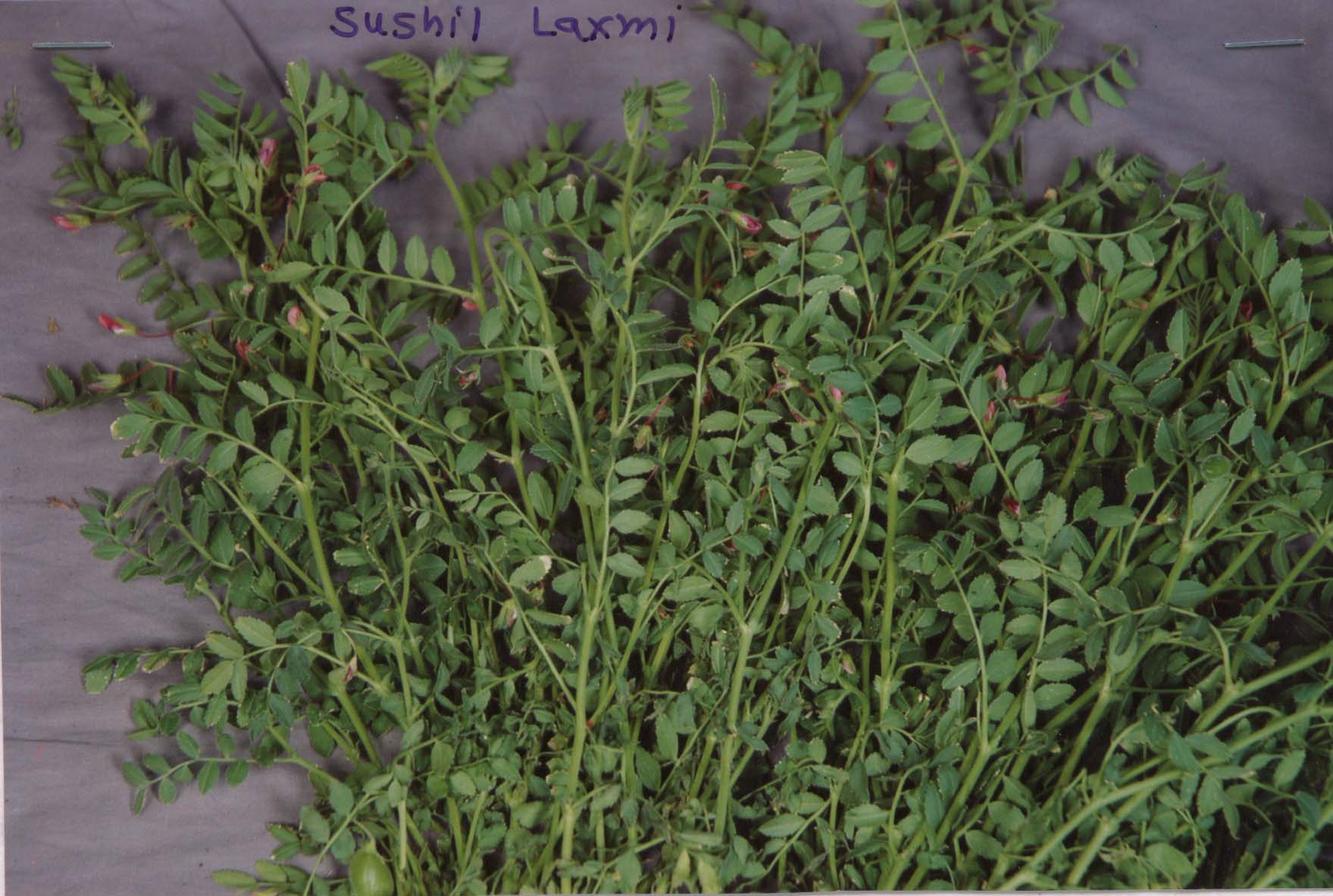New Gram Variety Sushil Laxmi
Genesis
In 1991-92, he went to Dharwad University along with his brother and got a chance to observe thebreeding program of gram there. Observing thescientists there making crosses to develop new variety, he became curious about the procedure and upon his return started the making various crosses using 110 flowers (male and female each). Pods were obtained in only 12 cross combinations and out of these one combination yielded dual pods/ axil. This was in the year 1993. He selected that plant and continued to multiply and observe the same for few years. He gave it to farmers for trial (30 - 40 acres). In 1997, when the characters got stablised, he named the variety ?Sushil Laxmi? after his mother?s (Sushila) and the Goddess of his villages? name (Laxmi). The same year he started a company named ?Sushil Laxmi Hybrid Seeds Pvt. Ltd.? While he was busy selecting and multiplying plants for developing his double pod variety, he had to continuously face ridicule from his villagers. In 1995, he took a sample plant in a saline water bottle and brought to ICAR, Delhi. On the way, he went to seek blessings from his religious guru, Acharya Nityanand ji. His guru called a press conference and invited journalist of Navbharat Times who later published a good news item on his innovation. He was later given an appreciation award by the then Transport Minister, Government of India. Later in 1996 he went to Delhi and showed his variety to the then Minister of Agriculture who waived the fee (Rs. 15,000) for variety testing from AICRP (All India Coordinated Research Project). Based on the encouraging results, he started selling his variety commercially in 1997-98. He claims that he developed many varieties of gram, primarily by selection process. His father wanted him to work on the sugarcane plantation, which was a cash crop while he wanted to research on the gram. He was given little over two acres of land for his gram crop. Since he did not have much land he lost all his developed varieties and could not preserve them. He took land on lease basis, cultivated gram on it, and bought it back by paying twenty percent more. The area under his gram cultivation is now more than 300 acres. Innovation He selected plants having features, viz., dual pods/ axil, bushy growth and dual seeds/pod obtained by crossing Annegari and Phule G 12 and then practiced rigorous recurrent selection for a period of eight years for stabilizing the characters. The prominent features of the variety that makes it market acceptable and highly popular among the farmers and the seed sellers are stability in performance in terms of yield (14-15 quintal/acre under irrigated and 9-10 quintal/acre under rain fed conditions), appearance of dual pods/axil to the extent of 60 per cent, bushy growth habit, higher harvest index (28 - 30 gram/100 grains) and better forage yield. The preference in the market for the harvest of ?Sushil Laxmi' is quite good as the grain is bold, uniform and also the colour of the grain is uniform and attractive. The produce gets easily sold in the market and fetches good price ranging from Rs. 1500 - 2000/quintal. The potential and worth of the variety can also be gauged from the fact that with very little effort on marketing it, it has registered a sale of about 600 quintals (year 2005) of seeds and advanced orders worth 1900 quintals (year 2006) have been already received. The variety is reported to be highly popular among the farmers across the states of Maharashtra, Karnataka and Madhya Pradesh. Apart from gram, he has been able to buy fifteen acres of land for his own cultivation on which he grows sugarcane. Seeing the success of his son now, his father is a happy man bur Balasaheb laments the fact that if his father had given him some land earlier he would have been able to save many of his gram varieties. Currently he is trying to experiment on bittergourd, lady?s finger and wheat. He claims to have developed a new variety of wheat by crossing Dharwad University variety DWR162 and a Rajasthan Variety Raj1555. The trials for the same are still going on.
Background
Balasahib Patil (39) has developed a high yield dual poded gram variety, which is more stable under both irrigated and rain fed conditions and has better fodder yield than the locally popular varieties.His family consists of his father, mother, wife and a baby daughter. His father was also an agriculturist and owned 14 acres of land. Sugarcane was grown in seven acres and on the remaining seven acres, they cultivated wheat and gram.Hasur, his native village is a medium sized one with a population of about 2800 people primarily engaged in agriculture. Various crops grown here are sugarcane, tomato, wheat, banana and gram. The village has underground sewage system since 1960 and has even won a state award for cleanliness. In 1966, his village got an irrigation system, which pumped water from nearby river and delivered water to the farms using cooperative pipelines.Balasahib is jolly natured and was naughty as a child, not much interested in studies. Swimming was his passion and his favorite past time was hanging out in groups with friends. Since childhood, the only thing he was interested in was agriculture. He started going to the fields only at the age of 15 years. He discontinued his studies after class ninth to pursue his dream of being a good agriculturist. Around the same time, his brother started a rice-puffing mill, which meant he had to allot most part of his time in agriculture rather than studies.
Awarded by NIF
patent filed no:REG/2008/467
NA
NA








